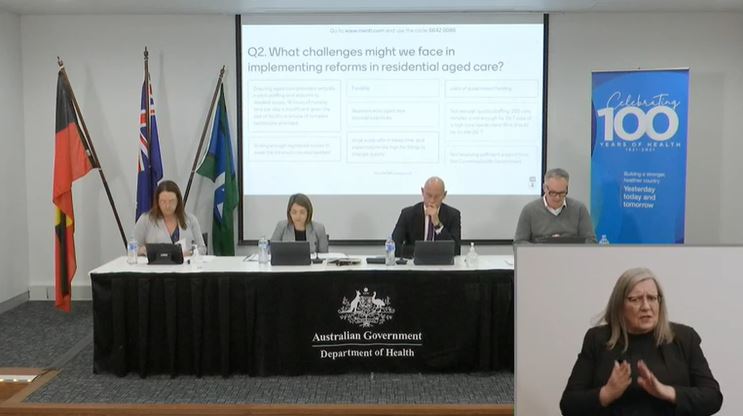The Department of Health has hosted the first three webinars in a series of seven on the aged care reforms announced in the 2021-22 Budget in response to the Aged Care Royal Commission – and there were some interesting insights.
The webinar on residential care on Tuesday – with over 1,000 participants including aged care workers, providers, academics and older Australians and their families – revealed important information about two of the most significant reforms: the $3.2 billion in funding to temporarily increase the Basic Daily Fee and the $3.9 billion in funding to increase care minutes to 200 minutes with 40 minutes of RN time by 2023.
You can watch Minister for Senior Australians and Aged Care Services, Senator Richard Colbeck’s closing comments, here.
$10 uplift in Basic Daily Fee to begin in August
Nick Hartland, First Assistant Secretary for the In Home Aged Care Division, said providers would be required to commit to new quarterly reporting requirements – in particularly around food and nutrition – next month with the first payment due in August and the first report due in October – just three months away.
Dr Hartland added that there will be some consultation with providers to refine the reporting requirements.
Staffing reporting to start in October
Providers will also be required to begin reporting on their staffing by October this year through their usual annual reporting to the Government, before reporting on staffing moves on a quarterly basis by July 2022.
From December 2022, this information will be utilised to inform star ratings before the introduction of the 200 care minutes requirement in 2023.
Again, the Department promised more communications as these measures are introduced.
 No stop-loss for AN-ACC
No stop-loss for AN-ACC
It was evident that many operators were following along.
One participant questioned why the Commonwealth had not implemented the 5% stop loss policy originally proposed under the AN-ACC model which would have provided any home experiencing a significant funding decrease with an initial stop-loss threshold of 5% and transition payments payable for up to two years from the date of transition.
Dr Hartland explained that the move to phase in AN-ACC at the time of the $3.9 billion increase for care minutes – plus a transition fund – meant that the Commonwealth no longer considered a stop loss mechanism was needed.
200 care minutes an average, not a minimum
The First Assistant Secretary also clarified that the 200 minutes was not a minimum, but an average for all care minutes delivered to all residents per day.
“Some will get more and some will get less,” he said.
There was also a clear message from providers that they wanted to be consulted by the Department on the reforms – not just the peak bodies.
Dr Hartland noted that participants had “quite a deal of enthusiasm and hunger to be consulted” and promised wider collaboration with all providers.
More red tape recognised
There was an acknowledgment too from the Department of the reporting – and paperwork – burden associated with the reforms.
“At the end of the day, we can’t … demonstrate … a quality aged care system if we don’t have transparency,” said Deputy Secretary of the Department, Michael Lye.
“That’s a non-negotiable aspect of the reforms.”
The impact of further consultation was also recognised.
“I know it’s exhausting for the sector,” said Dr Hartland.
“Many reforms are going to be complex and technical… we do need to engage with people on the ground.”
“It is going to be a transition process that will be rough for all of us.”
No real financial benefit
Colliers’ recent Federal Budget analysis noted that for many operators, the cost of compliance and new care minute requirements would effectively reduce the benefit of the extra ten dollars a day.
Also evident from the participants’ questions was that providers are well aware of the cost to their businesses.
You have to ask: how many operators will decide it’s all too difficult – and seek to leave?










